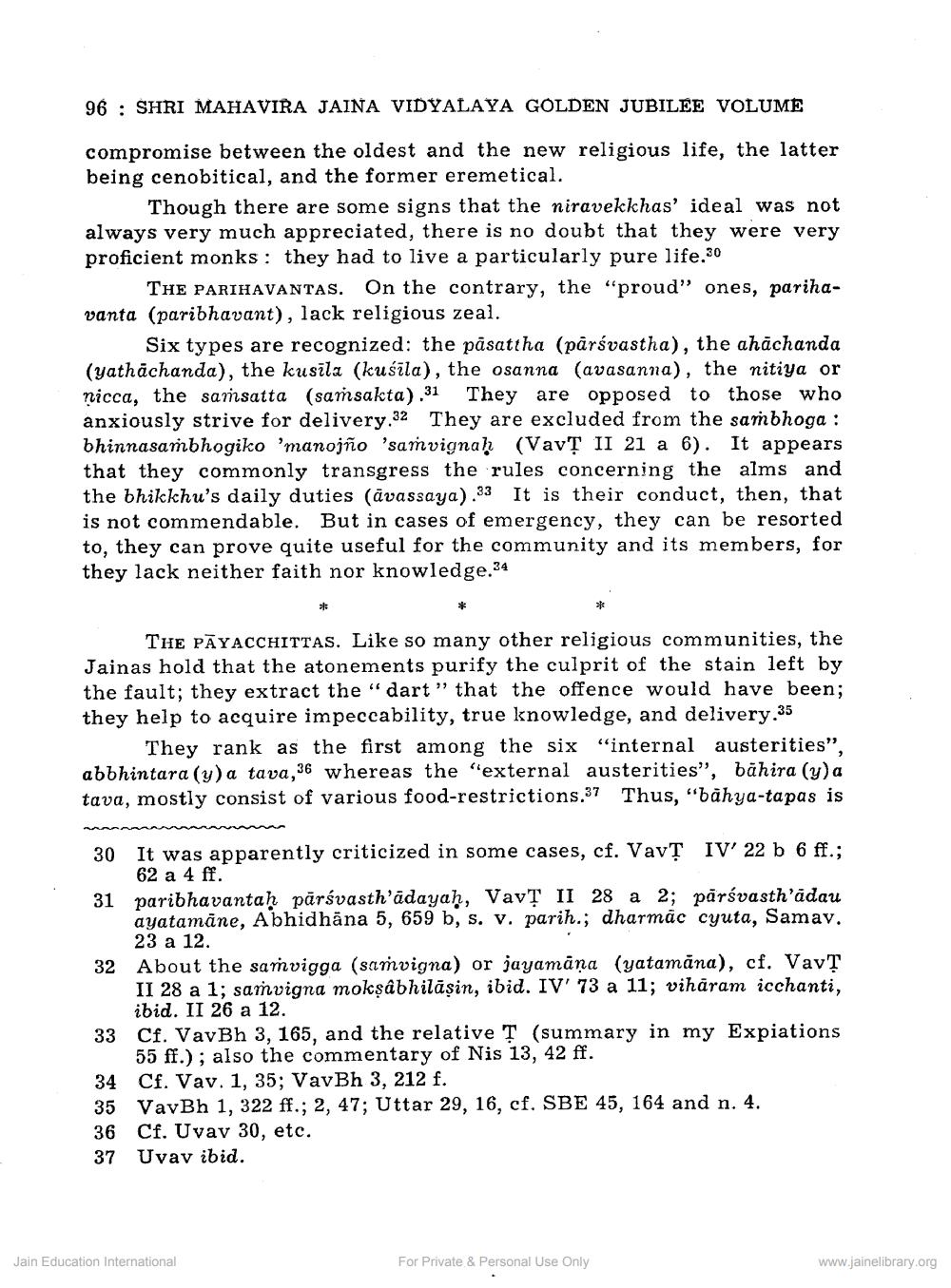Book Title: Religious Prayascittas according to old Jaina Ritual Author(s): Collete Caillat Publisher: Z_Mahavir_Jain_Vidyalay_Suvarna_Mahotsav_Granth_Part_1_012002.pdf and Mahavir_Jain_Vidyalay_Suvarna_ View full book textPage 9
________________ 96 SHRI MAHAVIRA JAINA VIDYALAYA GOLDEN JUBILEE VOLUME compromise between the oldest and the new religious life, the latter. being cenobitical, and the former eremetical. Though there are some signs that the niravekkhas' ideal was not always very much appreciated, there is no doubt that they were very proficient monks: they had to live a particularly pure life.20 THE PARIHAVANTAS. On the contrary, the "proud" ones, parihavanta (paribhavant), lack religious zeal. Six types are recognized: the påsattha (pärávastha), the ahachanda (yathachanda), the kusila (kusila), the osanna (avasanna), the nitiya or nicca, the samsatta (samsakta),31 They are opposed to those who anxiously strive for delivery. They are excluded from the sambhoga: bhinnasambhogiko 'manojfio 'samvignaḥ (VavȚ II 21 a 6). It appears that they commonly transgress the rules concerning the alms and the bhikkhu's daily duties (avassaya).33 It is their conduct, then, that is not commendable. But in cases of emergency, they can be resorted to, they can prove quite useful for the community and its members, for they lack neither faith nor knowledge.24 THE PAYACCHITTAS. Like so many other religious communities, the Jainas hold that the atonements purify the culprit of the stain left by the fault; they extract the "dart" that the offence would have been; they help to acquire impeccability, true knowledge, and delivery.35 == They rank as the first among the six "internal austerities", abbhintara (y) a tava, whereas the "external austerities", bahira (y) a tava, mostly consist of various food-restrictions. Thus, "bahya-tapas is AAAAAA 30 It was apparently criticized in some cases, cf. VavȚ IV' 22 b 6 ff.; 62 a 4 ff. 31 paribhavantaḥ pārávasth'ädayah, VavȚ II 28 a 2; pärśvasth'âdau ayatamâne, Abhidhana 5, 659 b, s. v. parih.; dharmac cyuta, Samav. 23 a 12. 32 About the samvigga (sarvigna) or jayamāņa (yatamâna), cf. VavṬ II 28 a 1; samvigna mokṣabhiläşin, ibid. IV' 73 a 11; viharam icchanti, ibid. II 26 a 12. 33 Cf. VavBh 3, 165, and the relative T (summary in my Expiations 55 ff.); also the commentary of Nis 13, 42 ff. 34 Cf. Vav. 1, 35; VavBh 3, 212 f. 35 VavBh 1, 322 ff.; 2, 47; Uttar 29, 16, cf. SBE 45, 164 and n. 4. 36 Cf. Uvav 30, etc. 37 Uvav ibid. Jain Education International For Private & Personal Use Only www.jainelibrary.orgPage Navigation
1 ... 7 8 9 10 11 12 13 14 15 16 17 18 19 20 21 22 23 24 25 26 27 28 29 30
